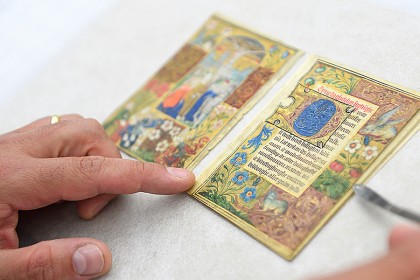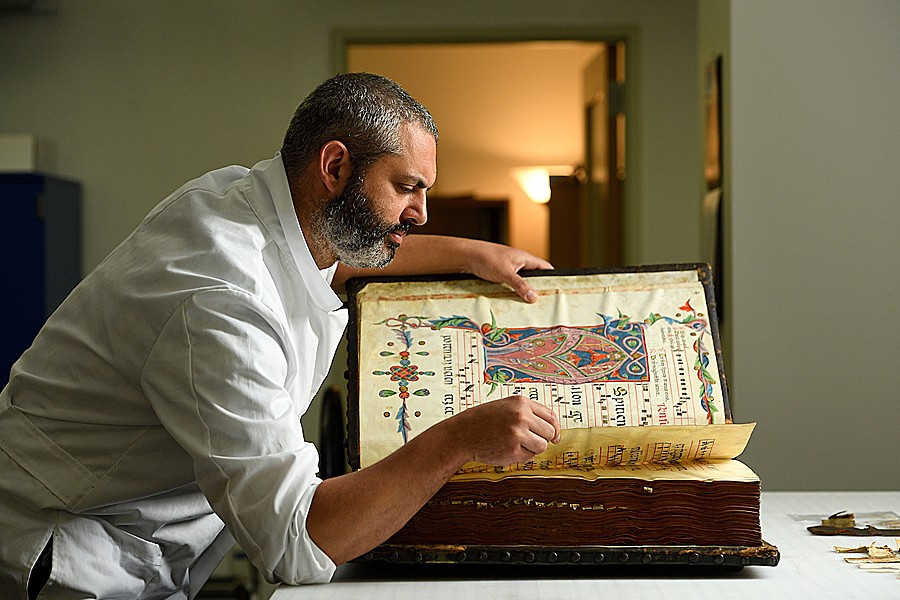If you're lucky, you've seen some of Johns Hopkins University's prized literary collections—maybe at Evergreen Museum and Library, the George Peabody Library, the Eisenhower Library, or elsewhere. That they're there, and in good enough shape to be displayed and even used, is thanks in part to the Sheridan Libraries' Department of Conservation and Preservation.
We headed to the department's basement lab in the Brody Learning Commons on the Homewood campus to talk to senior book conservator Alessandro Scola about preserving, repairing, and preparing books and other works for display.
So what does a book conservator do?
Our job is focused on preserving, conserving, and preparing and installing exhibitions. Preservation basically means monitoring the storage environment—the temperature, relative humidity, light level, and the presence of pests—and making sure it is within recommended museum standards. It also means providing books or documents with the proper enclosure, if necessary, which we create. That could be a folder, box, or encapsulation. Everything has to be precise, and we use only archival-quality materials, especially when it comes to Special Collections items.
And what about the conservation part of the job?
The conservation side is what we do mostly and what we are trained to do. It means fixing damages of, in particular, Special Collections items. It's mainly books, but we also deal with flat materials or documents. We make sure that our Special Collections items are available to scholars, researchers, and students. We are a research library, not a museum. In a museum, sometimes you just need to stabilize what you have, but a book is a functional object, and if it doesn't open, for example, that's a problem. It needs to work. We do paper repairs, but we are more specialized in mechanical or binding repairs, and we deal with a variety of materials other than paper—wood, paperboard, metal, cord, parchment, different types of leather and fabrics. So you need to have a broad set of knowledge and skills to do the job. It's a craft, so experience is also very important.
You also do a lot of work on exhibitions of books and documents, right?
Yes, that's the third big part of the job. Exhibitions in the past few years have been 40 percent or 50 percent of my time. There are several issues when you're displaying books because they are not meant to be displayed in the first place. For example, when you tilt a volume forward to make it more legible, gravity pulls the text block down away from the binding. This might cause permanent damage, so you need to counteract gravity and, in general, be very precise about all measurements, angles, and be careful in choosing the right cradle design. We make the stands here, and it's in a different kind of lab—it's a very maker space.
How long have you been here, and how did that come about?
I've been here almost four years. I'm Italian, and I met and married my wife in Northern Ireland while working on the same conservation project at the University of Ulster. We moved to the U.S. because she got a job at Columbia University. Then I got an opportunity for an internship in D.C. There I met the former director of this department, and here I am. My wife followed after a few years, and she's also a conservator here now. We're still working together! It's so rare. In this field, finding a good job is already winning the lottery, and we were able to find two in the same place.

Image caption: The Luneborch Prayer Book, an illuminated manuscript on vellum.
Image credit: Will Kirk / Johns Hopkins University
What is your average day like?
First, like everybody else in the world, checking emails. Then it's either on the bench doing some conservation work on books or making stands. In the last couple of years, I got passionate about that and wanted to create new designs. I think we have been pretty successful in that the Walters Art Museum asked us to train their technician in doing that. And Loyola University asked for help when planning an exhibit on fore-edge paintings. These are paintings created on the fore-edge of a book and only visible when its pages are fanned out in a particular way; you don't see them when the book is closed.
Do you have any favorite projects?
The book I'm working on now is a medieval manuscript, an antiphonary. It's a music book used in monasteries and churches in the 15th and 16th centuries. This one is from Northern Italy and has been at Evergreen Museum. It's huge and 40 pounds, almost impossible to move. Its text block is entirely made of animal skins, it has a number of beautiful illuminations, and its wooden binding still has all original metal furnitures on its edges. It's been a challenge because of its dimensions and because I approached it in an unorthodox way. The solution to the problem I found, I don't think you can find it in literature. That happens often because conservation is intrinsically a problem-solving activity, and you're constantly facing new or unexpected challenges. Sometimes you find the solution in literature, sometimes you need to come up with a new idea that hopefully will work. We proceed in a very controlled way so that if a technique or material is not performing as expected, we can undo it pretty easily and start over with something different.
Obviously you must have a fondness for books. But are there some that you're more excited about than others, in terms of conservation?
I'm excited when I find something unusual. It doesn't matter if it's 15th century or 18th century or 20th century. Something unusual to really push me to the limit—that becomes interesting instantaneously. But in general, I prefer pre-1800 items, the older the better. With the Industrial Revolution the quality of materials and techniques went downhill quickly. When you deal with earlier stuff, you can really see the ability of the craftsman of the time and the beauty and quality of the material.
What's a great day for you? One where you go home and feel really satisfied?
Well, when I've found a practical solution to a problem that had been in my mind for days, that's a great day. Or when a treatment is complete and I see the tangible products of my work. Or when a scholar or a student is able to consult a book that I have conserved. Or when an exhibit is finally installed and all the individual display items come alive organically and as a whole.
Any upcoming projects that are particularly interesting to you?
There is a little illuminated manuscript on vellum, the Luneborch Prayer Book, that's apparently the most precious book of hours in our collection. Its 26 miniatures have been attributed to the Dutch "Masters of the Dark Eyes," so named for the often deeply accented shadows around the eyes of their human subjects. So it's really a work of art and a book. It will be on my bench, maybe in the next few weeks. That project will be a complete conservation treatment, from cleaning and repairing each single page to a new leather binding, which is really exciting.
Anything you want people to know about book conservation and preservation here at JHU?
Our mission is to take care of our fantastic library collection—it really is fantastic—and make it safely available for present and future scholars and students. We continually try to bridge the gap between short-term safe handling and long-term preservation. As an example, a grad student is currently working on a 17th-century manuscript that has a unique binding structure that makes its opening rather difficult and potentially dangerous for the binding itself. In this case, it was decided to allow the student to consult the volume directly in our lab, using a custom-made reading cradle that keeps it safe but also allows it to be used.
Posted in News+Info
Tagged who does that?









